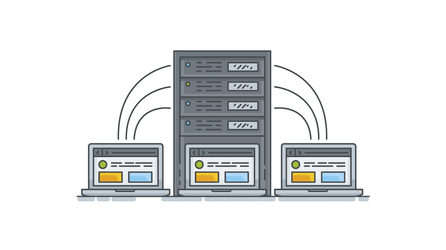Hosting Panels Overview
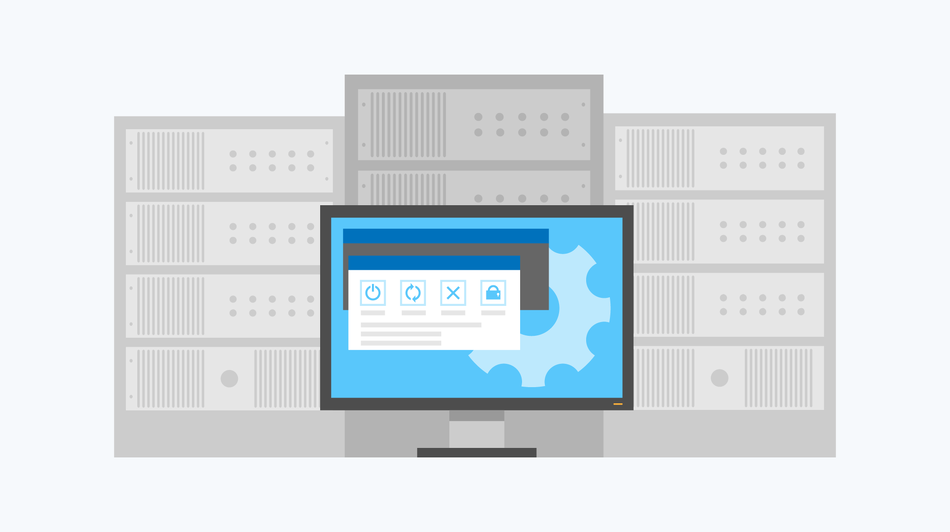
It is highly inconvenient and onerous to administer a web server via the command line. Some have trouble with commands, others find it difficult to configure the software correctly. Needless to mention the beginners accustomed to Windows. However, with a hosting panel, there is no more problem left. Hosting panel is a set of software, combined into some kind of interface, comfortable for a user.
With a panel you can administer your server in a browser via intuitive interface instead of unhandу command line. But for the web panel, even a beginner, devoid of any special experience, is able to configure a web server or launch a website.
Hosting panel functionality is really impressive: administration of mail services, data base, web servers, DNS, SMTP, POP3/IMAP and FTP. With one panel you are able to monitor statistics, install third-party software and do other necessary things.
No matter whether you launch only one website or work with the number of projects, a hosting panel helps you to cope with administration successfully and saves your time. We also would like to point out flexible account management. The majority of control panels basically have several access levels:
- Administer has the root-privileges;
- Reseller is given privileges by administrator;
- User has limited privileges, usually manages only a hosting.
There are dozens of hosting panels, both paid and free. The question is which is better to choose? What makes commercial products preferable to open-source ones? And are they actually preferable?
We have chosen the most popular and worth-trying panels from the whole wide choice. All the products presented below are of stabile work, flexible functionality and convenient interface. What is more, they work impeccably even on VPS with minimum system characteristics.
ISP Manager
ISP Manager – is a paid product from ISP System company. The first prototype of that hosting panel was launched in 1997, so it is one of the oldest of the kind. With the panel one can easily configure a website server, a DNS, a mail server and other services necessary for successful work of a project. Both panel core and user interface are written in C++. Web panel supports Linux and Windows system families.
License price: from 4 euro per month (ISP Manager Lite) to 12 euro per month (for Business version).
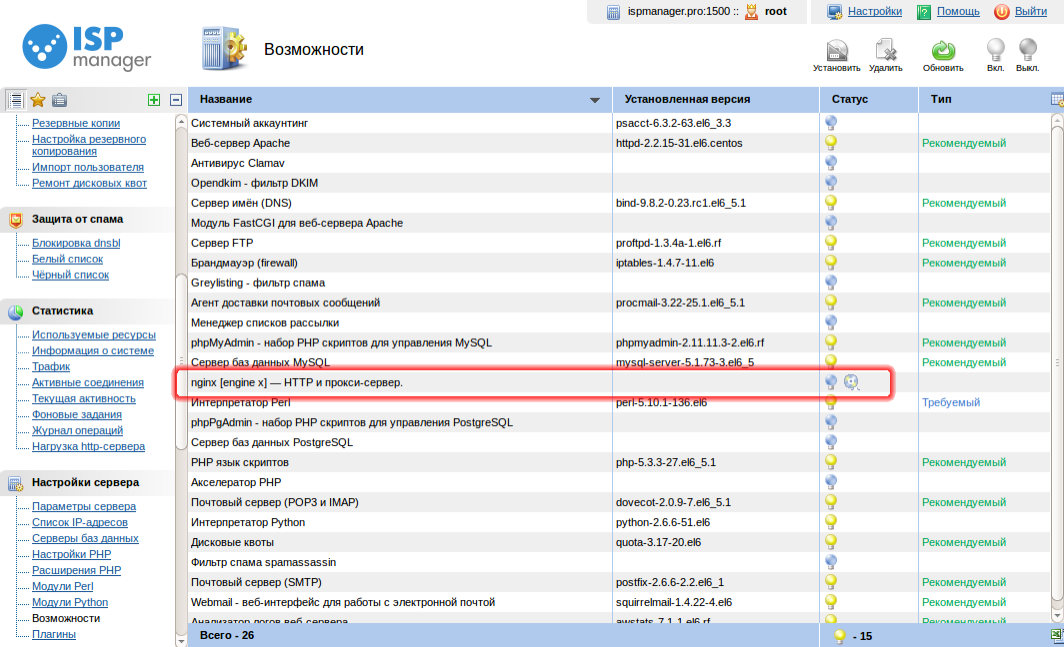
Installation: ISP Manager is installed via command line. The whole process is quite simple: you should only download and start the installation script – the software will cope with all the rest. The only thing you’ll have to decide on is the version (Lite or Business) and then just wait till configuration is done.
Functionality:
- Web server. The 4th version includes a preconfigured Apache web server by default. It is also possible to install Nginx on the web panel («Server settings» – «Facilities»). The 5th version provides an automatic configuration of Nginx + php-fpm complex during the installation. You may also activate Apache web server in the hosting panel.
- DNS. One of the most secure products - – PowerDNS - is set as a default application. Bind server is supported as well.
- Mail server. The hosting panel supports the majority of the most widely-used mail servers: Sendmail, Postfix, Exim, Communigate Pro, Greylisting, Dovecot. In the 5th version Exim is perfectly optimized.
- File management. ISP System has a file manager out of the box. For the security purpose it is disabled for the root-user. It is advisable to activate only for experienced professionals.
- MySQL and PosgreSQL data base management.
- Security. The panel has a preinstalled firewall, SpamAssassin antispam system with blacklist and whitelist functions. Please, pay attention! The firewall needs to be activated after installation.
- Account management. The following functions are available: user import, quotas management, user templates and backup configuration.
- The system supports Phyton, Perl, PHP. It is possible to set an individual PHP for each domain.
The 5th version has one important benefit – –you can customize your web server separately for each domain. In addition to this, it provides a semi-automatic CMS installation (website management systems: Joomla, Drupal, Mambo, etc.), a convenient intuitive interface, wide choice of languages and simple account transfer.
The difference between Lite and Business versions
While Lite-version is used only for server administration. Business-version gives you an opportunity to provide hosting services and includes broad functionality: cluster management, reseller user accounts administration, WWW-redirection, etc.
Advantages: simple intuitive interface, third-party software support, individual configuration for each domain.
Drawbacks: close source software, ISP Manager can be installed on the «fresh» server only.
Plesk Panel
It is another commercial product, developed by SWSoft team (redeemed by Parallels). Firstly launched in 2003. The panel is supported on usual servers with preinstalled Windows or Linux family operation system and on CloudLinux cloud servers.
Parallels Plesk has made itself a name among IT-professionals, big web studios and owners of several successful web projects. The panel is realized via PHP.
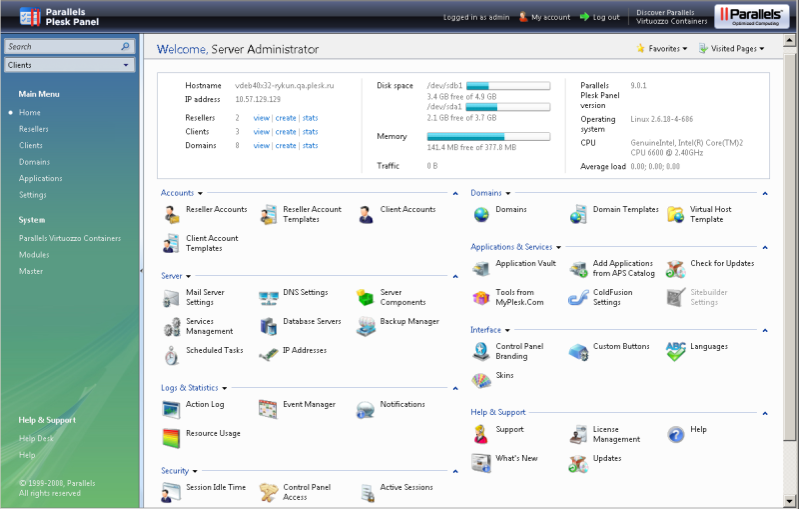
Installation: the process is similar to installation of other hosting panels: you should download and run the installation script, and the software will cope with all the rest.
Functionality:
- Apart from SSH and FTP, the panel supports encrypting protocol for SSL connection and has a certificate installation interface.
- Web server. By default the Nginx + Apache set is installed. The FastCGI utility is used to separate websites.
- Security. License cost includes SpamAssassin antispam system (has to be activated if necessary). An antivirus system has to be bought and installed additionally. A Firewall is activated by user in the hosting panel.
- Client manager. System of client addition and account transmission between servers via Migration Manager is very simple in Parallels Plesk. Clients there may be given different access levels. Account templates configuration is quite flexible and detailed.
- Data base management. The hosting panel supports MySQL and PostgreSQL.
- Website builder. The panel has a Parallels Panel SiteBuilder out of the box. It allows building a whole new website or adapting one of the templates.
- Extra plugins. There is a store inside the hosting panel, where you can find necessary software and install it in one click.
- Mail server. By default Linux versions have Postfix и Courier IMAP servers. Windows versions have – MailEnable. In addition, Parallels Plesk supports some widely used mail servers, like Qmail, Doveco, IceWarp или SmarterMail.
Panel’s interface has been carefully elaborated. Panel has an intuitive and user-friendly interface.
As for additional modules and extensions –, is the undisputable leader there. The problem is that all of them are paid and the license cost is rather high. Still, a non-professional user –will scarcely ever need any of them.
Advantages: convenient intuitive interface, flexible settings, great potential in client management, broad functionality, low system requirements.
Drawbacks: rather high price.
Ajenti
Ajenti – is Evgeny Pankov’s hosting panel. It is a comparatively new non-commercial project (firstly launched in 2010), though it has already got many positive responds. Its’ software is developed for UNIX operation system family. The core system and the front-end interface are written in Python.
The hosting panel consists of two parts:
- Server administration environment;
- Add-in AJenti-V for website management.
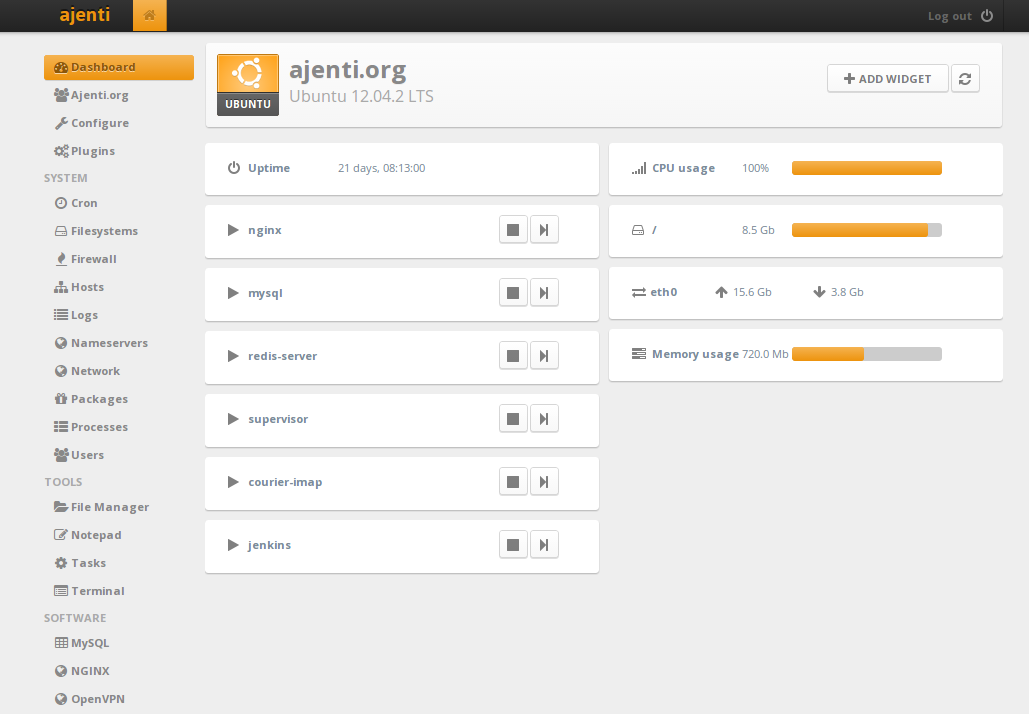
Installation: the process is pretty the same as for the commercial products above. The only difference – is that AJenti-V packets are installed separately, after the setup script is unpacked.
Functionality:
- Web server. The Nginx + php-fpm set is configured by default. Apache installation is optional.
- Mail server. Exim is optimized.
- FTP server: – Vsftpd.
- Data base management. AJenti supports PostgreSQL, MySQL.
- Third-party plugin support.
- The system supports Python and PHP.
Advantages: great potential in web server and website administration, intuitive interface devoid of excess modules, which is easy to cope with for a beginner user.
Drawbacks: Nginx and php-fpm configuration files have to be edited by the user. It is rather controversial point, as for beginners such operation is quite complicated, at the same time experts approve it.
Vesta CP
Vesta CP – is a new yet prospective project of Vesta company. The program appeared in 2012 and gained popularity among users at once. The packet is written in PHP and is free of charge. It supports a number of operation systems, such as RHEL; CentOS 5,6,7; Debian 6,7,8; Ubuntu 12.04-15.1.
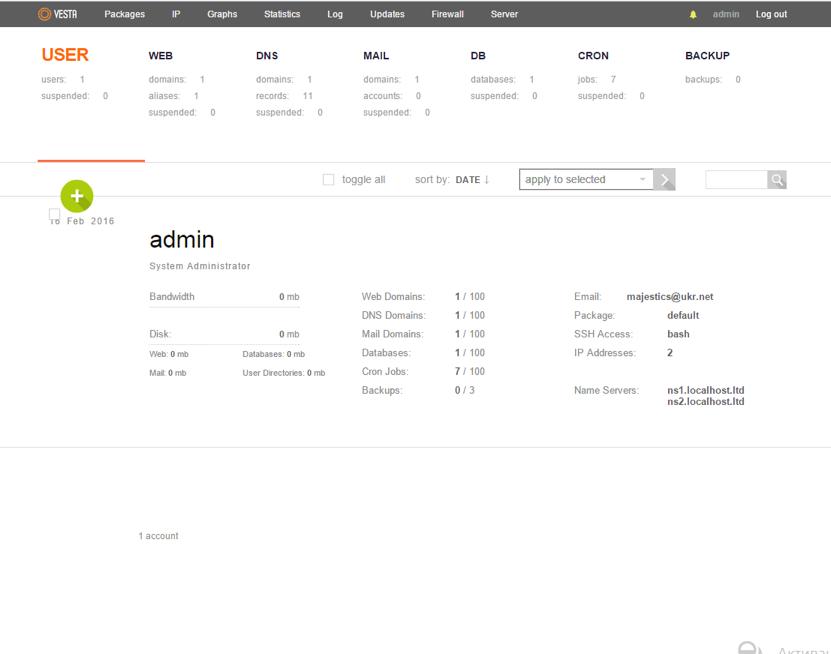
Installation: the process is as simple as for other hosting panels. You only need to download and install the installation script. Software is configured automatically; in case one of the components from the installation package has already been installed on the server, configuration copies will be saved. Once the installation is over you should only define NS and then launch the website.
Functionality:
- Web server. Apache is automatically configured. Nginx activation is optional.
- Tasks scheduler: Cron.
- Mail server: Exim.
- Firewall right out of the box, support of antivirus and antispam utilities ClamAV and SpamAssassin (additional installation is required).
- DBMS MySQL 5.5.
- DNS.
- FTP server: Vsftpd
- Perl, PHP, Python support.
Vesta CP stands out of the other free and paid web panels due to these two core characteristics:
- All the actions available on the web panel may be done via commands;
- Work with Apache mod_ruid2, which cooperates with mod_php. Because of the module it becomes easier and faster to manage access policy for usersб authorized on the same server.
Advantages: Vesta CP hosting panel has a minimalistic interface, which is very simple to use. It provides all the tools that a web developer needs: access rights management, domain and data base creation.
Drawbacks: Some operations, like PHP configuration, are still performed via command line only.
CPanel
CPanel – is a commercial product written in Perl. It was launched by CPanel Inc. in 1996. The software supports CloudLinux 5.x and 6.x cloud servers, as well as the ones managed by Сentos 5.x, 6.x, RHEL 5.x, 6.x. Up to 2014 there was also a Windows version available.
CPanel is mostly used by big companies and resellers. The software consists of two components: the user control panel and the WHM «root-user» web interface. The minimum license cost is 19 dollars monthly.

Installation: the process is similar to installation of other hosting panels, also a bit complicated with some extra operations. Just before starting the installation script, it is necessary to disable SELinux, install Perl and set the domain name.
Functionality:
- Client manager. This point was very well elaborated by the developers. You can vary access level, tune your plan and transfer accounts.
- Web server management. One of the biggest benefits of the hosting panel – is WHM EasyApache tool. It allows one to make fast and quick web server configuration via web panel and provides preinstalled and preconfigured profiles.
- Mail server. Exim server is used by default. Three mail clients are consolidated to use: Horde Webmail, SquirrelMail и RoundCube. The panel is fitted with the utility that tracks the delivery route.
- Data base management. The hosting panel supports MySQL and PosgreSQL.
- Extra plugins. WHM interface allows downloading and installing free modules from Google Store.
- Security. Right out of the box there is Spam Assassin mail antispam with blacklist and whitelist functions, and free ClamAV antivirus.
The hosting panel interface is simple yet pleasing the eye. The developers have stumbled though, as they did nothing to prevent inexperienced users from resetting important server settings.
Advantages: The panel is easy to use, which makes it popular worldwide, also it doesn’t require much resources.
Drawbacks: Website debugging is not automatic. License cost is rather high.
Conclusion
In the table below you may see the main parameters of the hosting panels:
|
Panel Name |
License |
Operation systems supported |
Frontend/Backend |
APS Support |
Администрирование БД |
ftp server |
Console |
Antivirus/Antispam |
Web server |
Mail server |
SQL |
DNS |
|---|---|---|---|---|---|---|---|---|---|---|---|---|
|
ISP Manager |
Paid Lite: 4 euro/mo. Pro: 12 euro/mo. |
CentOS > 6 Debian 7 FreeBSD 9 CloudLinux Windows |
C++/C++, sqlite |
+ |
phpMyAdmin |
SSH, |
Firewall management and antispam (blacklists, whitelits) out of the box |
Apache Apache + Nginx Nginx + php-fpm (for the 5th version) |
sendmail, postfix, exim, communigate pro |
MySQL PostgreSQL |
Bind PowerDNS |
|
|
Plesk |
Paid 5$/mo. or 385$/yr |
CentOS 5-7 Debian 6-7 Ubuntu LTS 10.04-12.04 RHEL 5-7 OpenSUSE 12.3-13.1 CloudLinux 5-6 |
PHP |
+ |
phpMyAdmin |
ProFTPd |
SSH, |
Fail2ban, Kaspersky Anti-Virus, Spamassasin (blacklists, whitelits) |
Apache + Nginx by default |
Sendmail Postfix |
MySQL PostgreSQL |
Bind |
|
CPanel |
Paid 20$/mo. (200$/yr) |
CentOS 5-6 RHEL 5-6 CloudLinux 5-6 |
Perl |
+ |
phpMyAdmin |
Pure-FTPd ProFTPd |
SSH, |
mod_security (tuning is possible), clamav, cPHulk, protection against bruteforce, jails for vhost apache via mod_ruid2 and cPanel jailshell |
Apache + Nginx и Nginx + php-fpm |
Exim |
MySQL PostgreSQL |
Bind MyDNS NSD |
|
VestaCP |
GPL |
RHEL 5-6 CentOS 5-6 Debian 7 Ubuntu 12.04-14.04 |
PHP |
- |
phpMyAdmin |
Vsftpd Pure-FTPd ProFTPd |
SSH, |
Firewall out of the box |
Apache Apache + Nginx |
Exim |
MySQL PostgreSQL |
Bind |
|
Ajenti-V |
LGPL |
Debian Ubuntu RHEL CentOS |
Python |
- |
phpMyAdmin |
Vsftpd |
SSH, HTML5 |
Firewall out of the box |
Nginx + php-fpm Nginx + uwsgi Nginx + Puma Nginx + Unicorn Nginx + Gunicorn Nginx + Node.js Nginx + Apache |
Exim |
MySQL PostgreSQL |
Bind NSD |
Having examined data about each web panel, one may conclude that free of charge hosting panels are not worse than the paid ones; if not to say they are better in some ways. Still, using the proprietary software makes sense, if one needs to provide maximum stability of portals work. For instance, in case you are the administrator of several websites on behalf of your clients.
Vesta CP Installation
All things considered, we’ve opted for Vesta hosting panel. First of all, Vesta CP is developed by the system administer, not the programmer, which makes it one of the most convenient programs to use. After installation you have all the necessary tools «right out of the box». Secondly, it’s not overloaded with modules and therefore is very easy to cope with even for a beginner-administer. Beside all that, it is free of charge.
The installation process of Vesta CP hosting panel is very simple and takes nothing more than 15 minutes. All the applications are installed and configured automatically, you only have to start the process.
To begin with, you should connect to the server with root-privileges. Then you should go to the folder, where the installation script should be downloaded:
cd /tmpNext you should download the script from the official repository:
curl -O http://vestacp.com/pub/vst-install.shIn case you don’t have Curl utility, you may use another path:
wget http://vestacp.com/pub/vst-install.shOnce the script is downloaded, run it:
bash vst-install.shThen you should confirm the installation by pressing “Y” and enter your e-mail address, where all the important information will be sent. The further installation will go automatically and will last about 15 minutes.
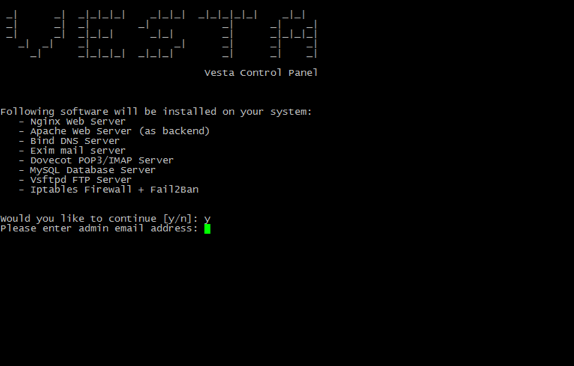
Once it is over, you’ll get the information to enter the hosting panel:
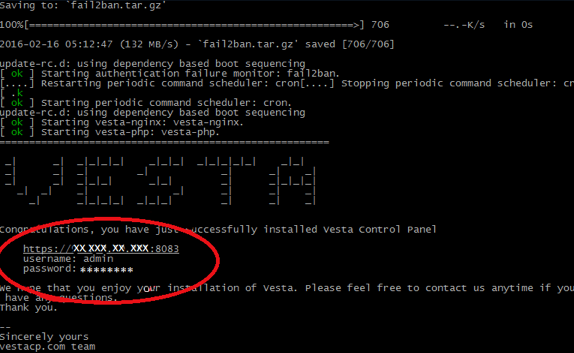
You should enter the address and the port number to the browser address bar to get the necessary authorization data.
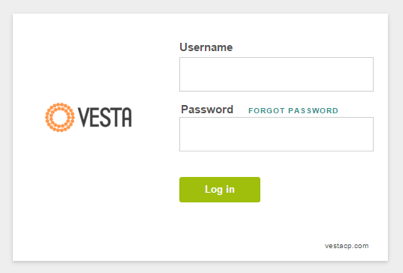
Now everything is ready for work with one of the best hosting panels.


